Friday, May 21. 2010
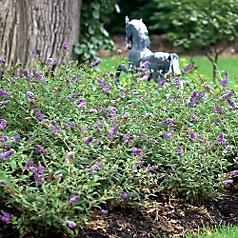 Something valuable for your garden: a dwarf Buddleia called "Blue Chip." This new Buddleia (Butterfly Bush) is only 2' high, max, and thus can function like a perennial flower in a border while drawing butterflies from miles around. Plus they claim it blooms all summer, unlike my full-sized Buddleias. I have a spot for a few of these guys. Something valuable for your garden: a dwarf Buddleia called "Blue Chip." This new Buddleia (Butterfly Bush) is only 2' high, max, and thus can function like a perennial flower in a border while drawing butterflies from miles around. Plus they claim it blooms all summer, unlike my full-sized Buddleias. I have a spot for a few of these guys.
Wayside is the only place I know that has them. Loony Greenies should avoid them: they are genetically-engineered. Like Labrador Retrievers, corn on the cob - and cotton.
Hummingbirds like them too.
Sunday, May 2. 2010
Saw this tree in bloom today behind a very good fish store, growing out of a hole in the asphalt. Never seen this sort of tree before. The wisteria-colored, tubular 2" blooms hang down, and last year's nut-like seed pods are still on the branches. The trunk looks like the trunk of a fast-growing trash tree. Quite a wonderful small tree, with the elegant blooms before the leaves emerge:
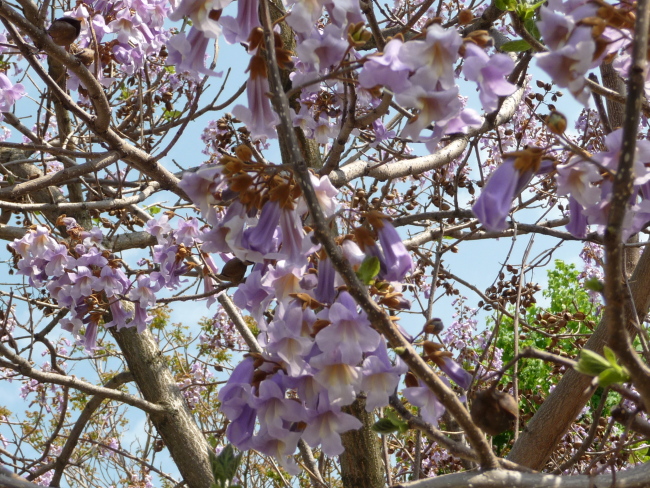
Reader got the name for me on the first try. Thanks. I had no idea what it was: The Empress Tree, Paulownia tomentosa. AKA Foxglove Tree. The blossoms do resemble Digitalis.
For an "invasive" trash tree which will grow anywhere, it sure is mighty purty in early May. My other photos of it below -
Continue reading "Who am I?"
Thursday, March 25. 2010
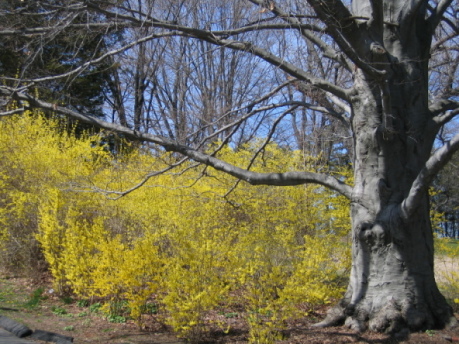
Well-organized amateur gardeners keep some sort of calendar or journal of annual tasks to be done (eg April: prune forsythias when blooms done), and a record of things planted (with exact names and maintenance needs).
I keep a casual record and to-do list on my computer with links to tips and info that I tend to forget (I do have a lot of plants with Special Needs), but some more serious folks prefer these pre-printed formats.
Tuesday, March 23. 2010

Constructing and maintaining shrub and perennial gardens is a Maggie's Farm hobby. Here's good gardening advice from a commenter at some gardening site I was looking at the other day:
JUST STOP!
Take a deep breath and a few steps away from the tree. Look at the package you have created and realize that you are more of a "crammer" than a designer. Your apparent desire is not to better display your specimen but rather to create more room to cram in ever more plants - "I want to be able to have the bottom more open for plants under it."
I believe the overall effect of your landscape would be much improved if you graduated to the design level where you begin an analysis of what you already have and start editing. DIY'ers often fail to realize that as gardens mature, they are dealing with a different set of design parameters than when they began. This present situation requires a different thought process.
When you first began, it was probably "more is better" because you had so much open space to fill. Your landscape has matured to the point that it is now craving some unity and simplification -- yet, here you are trying to figure out how to add even more.
When you go out, do you put on every piece of jewelry that you own or do you select only a few that serve to highlight? Think about your garden in the same way.
Image is a well-balanced garden, mature and perfect, at Christchurch, Oxford, from a post on English Gardens
Sunday, March 21. 2010
This specimen plant is a contorted variant of a member of the Hazel/Filbert family. It is of most interest when its leaves are off because the dense foliage conceals most of the branches.
Mine is coming into bloom with its catkins right now:

Sunday, November 29. 2009
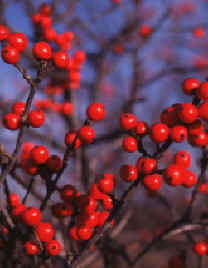 Bright red berries produced in the fall close along the stems of a deciduous shrub, most often in damp areas in the Eastern US, is Winterberry - Ilex verticillata. Bright red berries produced in the fall close along the stems of a deciduous shrub, most often in damp areas in the Eastern US, is Winterberry - Ilex verticillata.
Yes some ilex, ie hollies, are deciduous.
Many cultivars with larger and more abundant berries are now available of this native shrub. They are commonly used in weaths and Christmas plant arrangements. Still, the plant looks best in the woods and swamps.
Tuesday, August 4. 2009
 A family farmer in Missouri defends "industrial agriculture" against critiques by non-farmers like Michael Pollan. One quote: A family farmer in Missouri defends "industrial agriculture" against critiques by non-farmers like Michael Pollan. One quote:
...farmers have reasons for their actions, and society should listen to them as we embark upon this reappraisal of our agricultural system. I use chemicals and diesel fuel to accomplish the tasks my grandfather used to do with sweat, and I use a computer instead of a lined notebook and a pencil, but I'm still farming the same land he did 80 years ago, and the fund of knowledge that our family has accumulated about our small part of Missouri is valuable. And everything I know and I have learned tells me this: we have to farm "industrially" to feed the world, and by using those "industrial" tools sensibly, we can accomplish that task and leave my grandchildren a prosperous and productive farm, while protecting the land, water, and air around us.
Much of the criticisms of modern agriculture are, in my view, sentimental rather than realistic. Furthermore, as far as we can tell, "organic" foods have no advantage whatsoever. Food is food, and we are blessed to have enough of it to get fat.
Related, at Reason: A food elitist strikes back
We have a couple of Pee Wee Hydrangeas in our compact front entry garden, which is part shade. They are the dwarf form of the big Oakleaf Hydrangea, and are not too easy to find.
I highly recommend them for shrub/perennial borders. Like everything else, they take several years to reach their full size (which is around 3'x3' or 4X4). Ours are in full bloom right now:
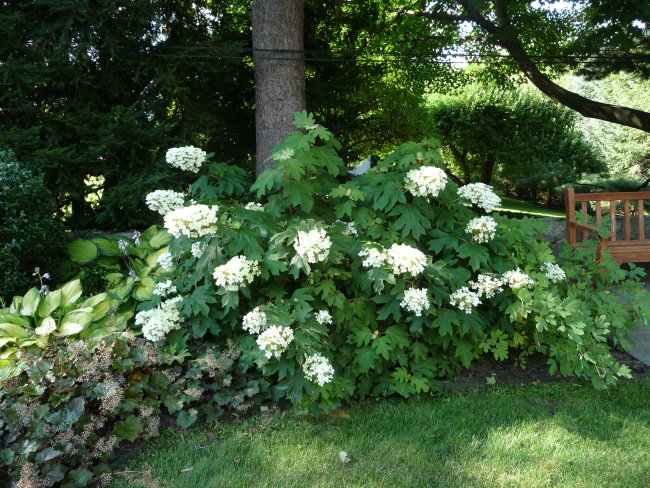
Wednesday, July 15. 2009
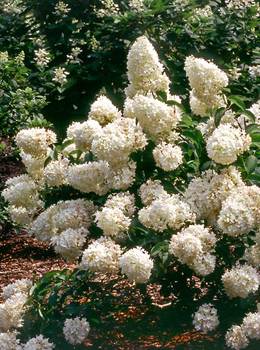 Mrs. BD loves her Little Lambs. It is a very special paniculata hydrangea. Mrs. BD loves her Little Lambs. It is a very special paniculata hydrangea.
I have never known anyone who did not enjoy hydrangeas.
Before you mess with hydrangeas, you need to know whether a plant is a macrophylla, oakleaf, arborescens, or a paniculata-type. The handling of each type is different - especially the pruning - and they vary in spring frost hardiness.
A good hydrangea site.
Monday, June 22. 2009
The Madame Hardy Rose, a Damask Rose, was bred by Alexandre Hardy in 1832.
My brother in CT emailed the photo with this note: "You gave this plant to me 15 years ago, and it's still doing well. I have never had a rose survive this long."

Wednesday, June 10. 2009
These folks waste no space on lawn, and seem to plant every spare inch except for grassy paths. But who does the weeding?

Tuesday, June 9. 2009
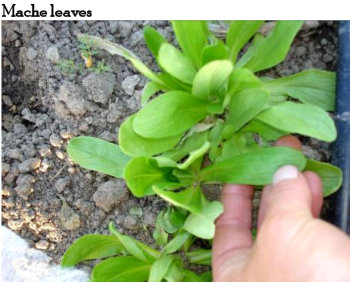 A few easy-growing salad (and I hate salad - rabbit food) greens for the garden that even I enjoy. I would never use these things in a mixed green salad, because you lose the flavor and character of the individual thing. A few easy-growing salad (and I hate salad - rabbit food) greens for the garden that even I enjoy. I would never use these things in a mixed green salad, because you lose the flavor and character of the individual thing.
These are greens that you can plant every two or three weeks during the spring and summer, and harvest small and tender. Some of them will grow back after harvesting the leaves. They are often commercially grown hydroponically these days.
My favorite is Mache (aka Corn Salad), a sweet, tender mayonnaise-tasting leaf
Frisee, a member of the Chickory family. Bitter, tangy, crunchy: good to precede a game meal, grilled lamb, or steak. Never salad with the main course, in our view, unless it's a buffet, because salad dressing messes up the flavors of the main course.
Garden Cress, a member of the Mustard family. Sort of like Watercress.
Dandelion. Spicey with a bit of crunch.
Arugula. The strange kerosene flavor grows on you. Just try to ignore the fact that Liberals like it.
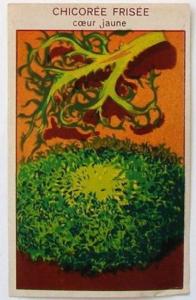
Short growing season up here. Ours are just getting going, but I already have some blossoms. Please do not tell me what you have in South Carolina, Tennessee, and Missouri. Fact is, I do like it here despite the high taxes and the short growing season.
We do not even bother with the Beefsteaks and Beefmasters. No point to it. Lucky to get a decent harvest of them before the first frost. Big Boys work, though, and they are OK. Each one of my plants is a different variety. I like the pear-shaped mini yellows, the orange ones, the sweet millions, the Big Boys and the Big Girls, etc etc.
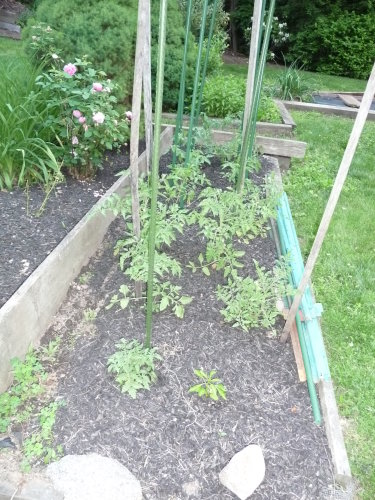
Monday, June 8. 2009
Re BD's post on Rose Aphids yesterday: The reason you have them this year, BD, is probably because you over-fertilized them during a very wet and rainy Spring which resulted in an over-abundance of the soft, succulent growing tips which aphids love to suck on. But I could be wrong.
Sunday, June 7. 2009
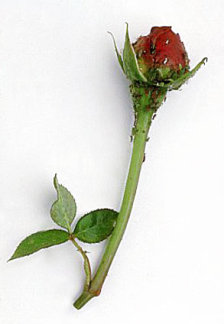 They say that fully healthy roses cannot be harmed by aphid infestations, and that may be true. However, we do not live in an ideal world, and it makes no sense to go out on strike until it appears. They say that fully healthy roses cannot be harmed by aphid infestations, and that may be true. However, we do not live in an ideal world, and it makes no sense to go out on strike until it appears.
We have abundant Rose Aphids this spring, but haven't seen them for the past few years.
We mix liquid dish soap at the rate of 1 tbsp/gallon in spray bottles, and spray the roses, especially their succulent tips, with it. Dead aphids by the thousands, without poisoning anything else. The surfactant suffocates the buggers. I brush off any Ladybugs first.
Mrs. BD claims that she is waterboarding them to death.
One treatment ought to do it. Best done before the first bloom. Had to do it today.
Wednesday, June 3. 2009
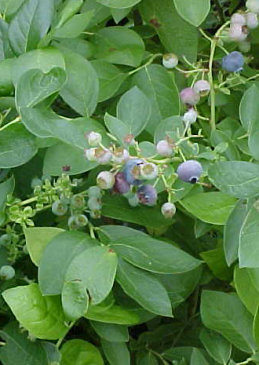 Re our post on Blueberries today, I found a source for the wild type, non-hybridized highbush blueberry. Re our post on Blueberries today, I found a source for the wild type, non-hybridized highbush blueberry.
I would suspect that these would naturalize well, given the right damp, acidic and sunny location. (The cultivated blueberrys do not seem to naturalize.) In fact, I have a spot that might work well for them, but whether the soil there is acidic enough I do not know.
Come to think of it, if it were just right for them, they would probably be there already.
Thursday, May 28. 2009
A planted space (aka "a garden") isn't a "space" without the sense of, a suggestion of, or the reality of, enclosure - regardless of scale; whether the scale is a 20X20' herb or rose garden or a 50-100 acre meadow bounded by woods or windbreaks. Just like a picture wants a frame.
I think that comfortable feeling is deeply embedded in the human soul, and it is the reason garden designers speak of outdoor "rooms." I kinda prefer designing or thinking about outdoor "hallways" - the paths which lead from space to space. Hallways, though, must lead to rooms or they have no meaning and no purpose.
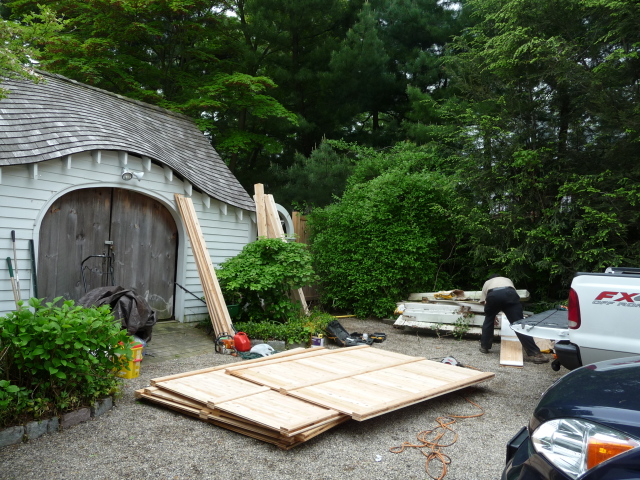
Tuesday, May 26. 2009
Yesterday:
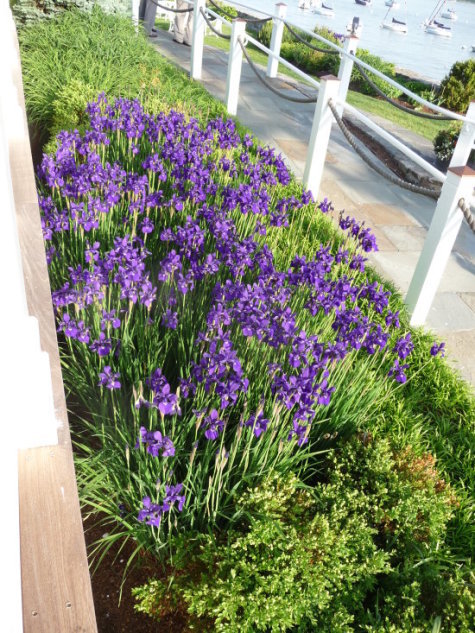
Wednesday, May 20. 2009
The new garden path that I mentioned on the Spring to-do list. Besides looking nice, it solved the problem of the previously muddy route that the dog always takes on his routine patrols for enemies and intruders. Fortunately, he likes the new path. No, I did not build it myself but I could have, given the time.
The Mrs. did a nice job with her new semi-shade border, but it will take a year or three to mature. As you can see, I pruned the heck out of that young Crepe Myrtle behind the hybrid Rhodies. Maybe too much. That's a small Kousa Dogwood on the corner.
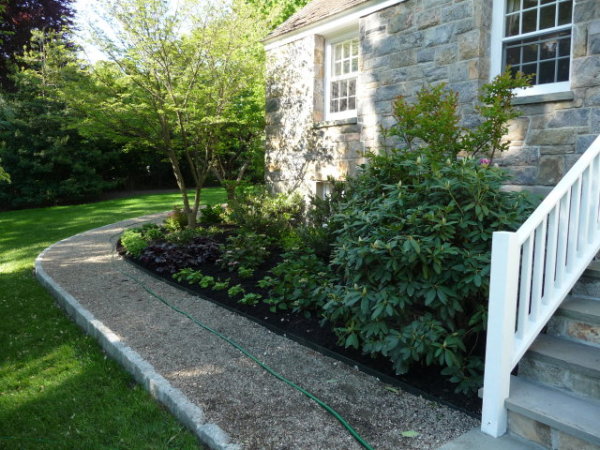
Saturday, May 16. 2009
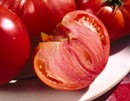 I am putting mine in the ground today, after using my car as a greenhouse for a couple of weeks. I have 6 varieties this time. Always those Sweet Million cherry tomatoes, and always the classic Beefsteaks, even though they aren't ready around here until mid-late August. Still worth it for a few weeks of them. Some yellows. No plum tomatoes - the canned are fine with me if they are going to be cooked anyway. I am putting mine in the ground today, after using my car as a greenhouse for a couple of weeks. I have 6 varieties this time. Always those Sweet Million cherry tomatoes, and always the classic Beefsteaks, even though they aren't ready around here until mid-late August. Still worth it for a few weeks of them. Some yellows. No plum tomatoes - the canned are fine with me if they are going to be cooked anyway.
Are yours in yet?
Friday, May 15. 2009
I think we did a good job on this little corner. Nepeta (which won't be blooming for a while), some giant allium and regular allium in bloom right now, Wisteria overhead getting ready to bloom (pruned them so hard this winter they might be disappointing this Spring), low boxwood hedging and a thick row of those dwarf yellow lilies heading up on the right. I forget the name of those clumps of bulbs with the bell-like purple flowers, but they are pleasant.
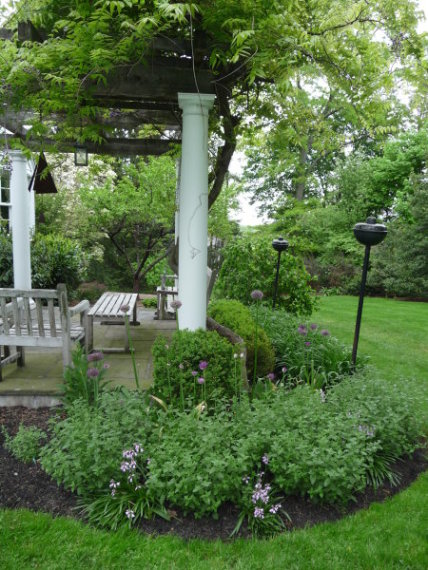
Saturday, May 2. 2009
The pup just ate two baby bunnies (Cottontail rabbits). One baby ran away. He found their nest while we were doing outdoor clean-up. The pup was helping, of course.
It's always been my philosophy that too much outdoor clean-up is bad for the wild critters, and we love our wild critters. The early Mother's Day present to the Mrs. was the work of 4 yard guys for 4 days, plus however-many truckloads of black mulch, plus a couple of dumpsters. Three loads of mulch did the job, barely, but the garden beds look spiffy for the moment. But, sadly, with fewer bunnies.
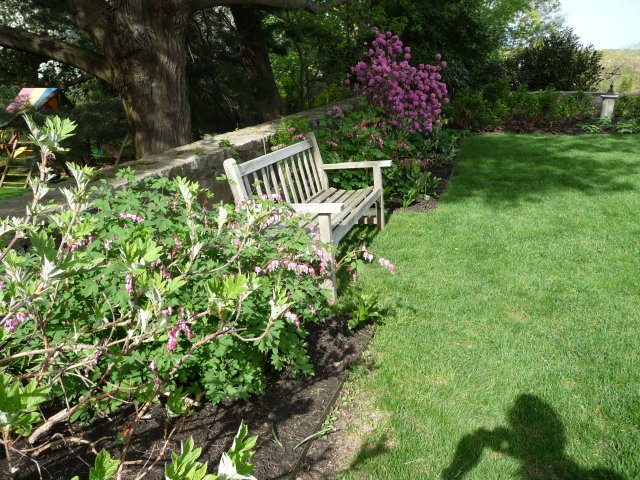
Thursday, April 30. 2009
That's our second truck load of it. This black stuff looks best, and only costs a little bit more for your garden beds. A 6" layer does the job.

Sunday, April 19. 2009
That plant I posted below is indeed Lesser Celandine, beloved by Wordsworth but an invasive plant species (eg illegal alien weed) in the Atlantic US.
|


 Something valuable for your garden: a dwarf Buddleia called "Blue Chip." This new Buddleia (Butterfly Bush) is only 2' high, max, and thus can function like a perennial flower in a border while drawing butterflies from miles around. Plus they claim it blooms all summer, unlike my full-sized Buddleias. I have a spot for a few of these guys.
Something valuable for your garden: a dwarf Buddleia called "Blue Chip." This new Buddleia (Butterfly Bush) is only 2' high, max, and thus can function like a perennial flower in a border while drawing butterflies from miles around. Plus they claim it blooms all summer, unlike my full-sized Buddleias. I have a spot for a few of these guys.

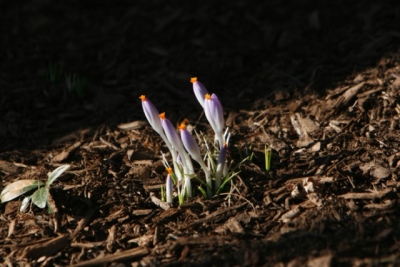
 Bright red berries produced in the fall close along the stems of a deciduous shrub, most often in damp areas in the Eastern US, is
Bright red berries produced in the fall close along the stems of a deciduous shrub, most often in damp areas in the Eastern US, is  A family farmer in Missouri
A family farmer in Missouri  Mrs. BD loves her Little Lambs. It is a
Mrs. BD loves her Little Lambs. It is a 

 A few easy-growing salad (and I hate salad - rabbit food) greens for the garden that even I enjoy. I would never use these things in a mixed green salad, because you lose the flavor and character of the individual thing.
A few easy-growing salad (and I hate salad - rabbit food) greens for the garden that even I enjoy. I would never use these things in a mixed green salad, because you lose the flavor and character of the individual thing. 
 They say that fully healthy roses cannot be harmed by aphid infestations, and that may be true. However, we do not live in an ideal world, and it makes no sense to go out on strike until it appears.
They say that fully healthy roses cannot be harmed by aphid infestations, and that may be true. However, we do not live in an ideal world, and it makes no sense to go out on strike until it appears. Re our
Re our  I am putting mine in the ground today, after using my car as a greenhouse for a couple of weeks. I have 6 varieties this time. Always those Sweet Million cherry tomatoes, and always the classic Beefsteaks, even though they aren't ready around here until mid-late August. Still worth it for a few weeks of them. Some yellows. No plum tomatoes - the canned are fine with me if they are going to be cooked anyway.
I am putting mine in the ground today, after using my car as a greenhouse for a couple of weeks. I have 6 varieties this time. Always those Sweet Million cherry tomatoes, and always the classic Beefsteaks, even though they aren't ready around here until mid-late August. Still worth it for a few weeks of them. Some yellows. No plum tomatoes - the canned are fine with me if they are going to be cooked anyway.